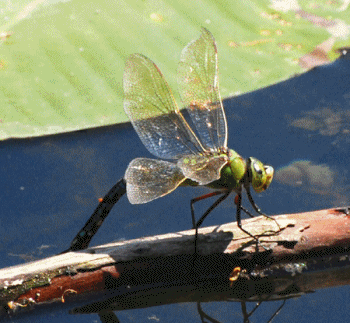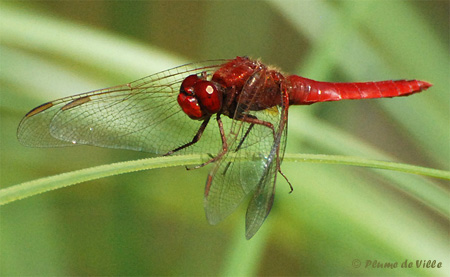Plume de Ville
Libellules.
°°°°°°°°°°°°°°°°°°°°°°° °
July 2009
July 6th
In a rustle of wings, in
flight, the mating of black-lined skimmers,
which gently landed a short instant, just enough time for a photo.
I
love the
elegance of the laying of the black-lined
skimmer.
This beautiful female with her male was in the midst of laying. Large
curves
over water and in the descent, light touch of water and up in the same
movement, continues its fly smoothly and new descent. All smoothly.
Monsieur
keeps watch.
The
Emperor
is aging. It continues to patrol but stops more often for a few moments
of
rest. The wings must have been in battles.

Madam still
lays. Here it is an amazing way of laying. Two passages on one side and
then
reverse and she puts its abdomen on the other side. Two movements of
the other
side and on again. This is a sequence of 30 seconds, but spawning
lasted much
longer.
Another
lying of the broad-bodied chaser. When it chooses a place, it puts its
abdomen
vertically and "punctures" again and again in the same place.
Always very
difficult to catch in a photo.
July 10th
The
small
red-eyed damselflies [Erythromma viridulum] stay together. Laying in a
group
but far enough from the bank. If the male has the choice, it seems to
alight on
vegetation rather than to sustain the female.
(Ph. 240609)
(Ph.
070709)
Males
rest
on on floating vegetation.
End of June many couples were laying. On July 7, only males where
alight.
July 14th
Scarce chaser.
[Libellula fulva]
The couple alighted immediately on the bank. They stayed at the same
location,
changing only once for another strand of grass, disturbed by another
male.
The
female
lays alone. Three quarters of an hour later I had to quit, leaving them
at the
same place and I didn't saw the laying.
Females
lose their orange colour as they age. On this one, we still distinguish
some orange colour.
You must cling! A gust of wind and there they are, wrapped in their wings. It was very windy that day and they were well shook.
(ph. 230609)
La scarce
chaser does not tolerate any other "blue" in its territory but dame
black-tailed
skimmer (Orthetrum cancellatum) has the right to share its patch of
grass.
A
look of not
yet ripe apple for the head of this ruddy darter [Sympetrum
sanguineum].
The bottom of the eyes of this young male is still green. Later its
face will become
bright red.
ph. 290609

Nice sympetrum, always so likable and ready to pose so kindly.
July 16th
The brown hawker [Aeshna
grandis].
His wings are golden, smoked amber coloured.
This is a great and beautiful 7cm dragonfly all honey. Beautiful
spectacle to
see her fly
It flies in
graceful curves and gliding.
Unfortunately I have not seen the male or mating. No male around during
spawning.
It laid close enough to the bank, changing the place of spawning after
30-40
seconds, sometimes returning to the same place.
She was kind enough to stay on my side of the bank after laying on the
opposite
bank where I thought that had lost it.
Spawning lasted about ten minutes.
(Ph. 150709)
July 20th
Red, red,
all is red in the scarlet dragonfly [Crocothemis erythraea].
The legs,
chest, the flat abdomen and the broad face
A small
bluish streak behind the eyes, almost nothing.
ph. 240609 070709
A small
yellow spot at the base of the hind wing.
(ph. 070709)
Let's stay
with the red of the red-veined darter [Sympetrum fonscolombii].
I
have seen
several since the end of June around a clayey pond recently.
ph. 240609
(ph. 070709)
Mid July, they are still numerous.
(150709)
July 22th
'O Sole mio...
A good surprise to meet
these two ones.
The Lesser emperor. [Parthenope Anax-Anax-Aeshnides -]
It is a bit smaller than
the Anax imperator (7cm).
The wings, especially here, the female ones, are tinged with brown from
the
middle of the wing and the pterostigma.
Ring yellow contrasting with the blue to the top of the abdomen and
green eyes
over brown thorax background.
I saw it
fly very aggressively over the pond without succeeding to catch it in
photos.
That
day,
here it is in tandem and good look they alight near the bank to spawn
in an iris
leaf soaking in water.
Among the few Aeshnidae which lay in tandem.
Spawning
lasted very long.
All
at the same place, except for a small fly over the water to alight a
little
farther from the bank on a tree branch and another vertical
displacement in the
same iris.
Some
eggs laid and return almost immediate to their favourite bunch of iris.
This laying was so long on the same leaf, that these two white-legged
damselflies
[Platycnemis pennipe] took the abdomen of the female for a nice twig!
35mn
spawning
and I do not know if they parted to spawn a little further. I did not
saw them
separate when they flew.
(Ph.200709)
23 juillet
Accouplement du Sympetrum sanguin [Sympetrum
sanguineum].
Une belle femelle bien placée sur sa branche prenait le
soleil, vite rejointe par un mâle posé non loin de
là.
Deux minutes plus tard la ponte commence.
Le mâle continue de tenir la femelle et la monte et la descend sur le lieu de ponte choisi. La femelle accompagne car elle bat aussi des ailes. Il plonge en avant entraînant la femelle qui lâche alors ses œufs que l'on aperçoit au bout de son abdomen puis remonte.
Le lieu choisi n'est pas au-dessus de l'eau mais au sec, sur
la berge au-dessus d'une touffe de carex dont le centre est sec,
à un
mètre de l'eau. Habituel pour le Sympetrum de pondre ainsi
"à terre" mais surprenant.
Les œufs resteront en "sommeil" (diapause), c'est
à
dire que leur développement sera
arrêté, indépendamment de conditions
environnementales ou de facteurs défavorables (nous sommes
mi-juillet,
il fait beau...). La diapause est génétique. Les
œufs passeront l'hiver
et écloront
le printemps
suivant.
Une minute plus tard ils se séparent et la femelle continue
de
pondre seule, laissant tomber ses œufs qui forment ce collier
de
perles. Le mâle posé non loin de là,
veille.
Pour avoir une idée de l'échelle, voici
à droite une vue de l'endroit de la ponte, on distingue
l'eau
un peu plus loin en arrière. Les œufs sont
largués de haut. Le sol ne
se voit pas, il est encore plus bas, le Sympetrum sanguin ayant pour
taille environ 3,5-4 cm la vue
d'ensemble ne l'aurait pas montré. On arrive à
distinguer encore le point blanc des œufs au bout de
l'abdomen.
(Ph.200709)
Un peu plus...
http://en.wikipedia.org/wiki/Diapause



